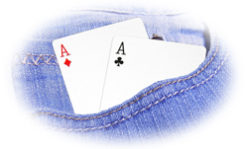In many card games, a round of play consists of some number of “tricks” where each player presents 1 card. Then, by some criteria, 1 player will “take” the trick.
The first person to play in a trick “leads” the trick. Usually, this person chooses a suit that must be followed or trumped. In that case, the following players must, if they can, play a card from the same suit as the leading card. This may be referred to as the “lead suit” of the trick. If the player cannot play the lead suit or the trump suit, then they may play a “slough” card, which is guaranteed not to take the trick.
In some games (as in up the river), the rules will specify that you do NOT need to “play to kill” and that may mean that you do not have to follow suit or play trump before sloughing cards. In those games, cleverly sloughing cards is a winning strategy.
Once all players have presented their card for the trick, the person who takes the trick is usually the person who has the largest value trump suit or the largest value lead suit.
Taking the trick may be generally desirable to gain points (as in pitch), or it may be generally undesirable (as in hearts).
Typically, the number of cards dealt to each player’s hand is the number of tricks in the round, and there may be multiple rounds of play.
